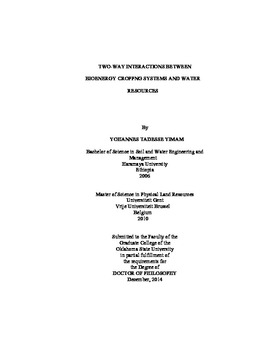| dc.contributor.advisor | Ochsner, Tyson E. | |
| dc.contributor.author | Yimam, Yohannes Tadesse | |
| dc.date.accessioned | 2016-01-20T15:45:11Z | |
| dc.date.available | 2016-01-20T15:45:11Z | |
| dc.date.issued | 2014-12 | |
| dc.identifier.uri | https://hdl.handle.net/11244/25739 | |
| dc.description.abstract | Understanding the two-way interactions between bioenergy cropping systems and water resources is imperative for the successful deployment of these crops in the US Southern Great Plains (SGP); however, such information is limited in the region. This study was conducted (i) to quantify and compare water budget components under switchgrass, biomass sorghum, and mixed perennial grasses in Oklahoma; (ii) to partition evapotranspiration (ET) components and determine the water use efficiency (WUE) of these cropping systems; and (iii) to model watershed scale hydrological impacts of switchgrass biomass production on grasslands versus marginal croplands. Soil water content was measured regularly from 2011 to 2013 at two locations, and ET was estimated using the soil water balance approach. The ET was partitioned by measuring canopy interception and estimating soil evaporation. Transpiration was calculated as the difference. WUE was estimated as the ratio of above-ground biomass produced to ET and transpiration. The Soil and Water Assessment Tool (SWAT) was used for the watershed-scale study. The result showed that soil water depletion occurred mainly above 2 m under all crops considered. The total growing season soil water depletion varied from 4 to 287 mm depending on the initial soil water content and growing season rainfall. Crop year ET also varied from 493 to 846 mm and was greater for perennial grasses than biomass sorghum except during a wet year when the two systems had similar ET. Transpiration was the largest component of growing season ET for all cropping systems. The non-productive loss portion of ET was greater for biomass sorghum than switchgrass, but biomass sorghum had higher WUE than switchgrass, which compensated for its higher non-productive losses. SWAT simulated average switchgrass yield of 12 Mg ha-1 on grasslands and marginal croplands along with an increase in ET and reduction in streamflow relative to the baseline scenario. The hydrologic cost per ton of biomass production is predicted to be approximately five times greater for grasslands than marginal croplands. In the SGP, rainfed bioenergy production system based on biomass sorghum may consume less water per unit land area than systems based on perennial grasses, but the non-productive losses and other ecosystem services need to be considered. From a hydrologic perspective, it may be preferable to convert marginal croplands to switchgrass production rather than converting existing grasslands. | |
| dc.format | application/pdf | |
| dc.language | en_US | |
| dc.rights | Copyright is held by the author who has granted the Oklahoma State University Library the non-exclusive right to share this material in its institutional repository. Contact Digital Library Services at lib-dls@okstate.edu or 405-744-9161 for the permission policy on the use, reproduction or distribution of this material. | |
| dc.title | Two-way interactions between bioenergy cropping systems and water resources | |
| dc.contributor.committeeMember | Kakani, Gopal | |
| dc.contributor.committeeMember | Zou, Chris Bocai | |
| dc.contributor.committeeMember | Fox, Garey A. | |
| osu.filename | Yimam_okstate_0664D_13661.pdf | |
| osu.accesstype | Open Access | |
| dc.type.genre | Dissertation | |
| dc.type.material | Text | |
| thesis.degree.discipline | Soil Science | |
| thesis.degree.grantor | Oklahoma State University | |
